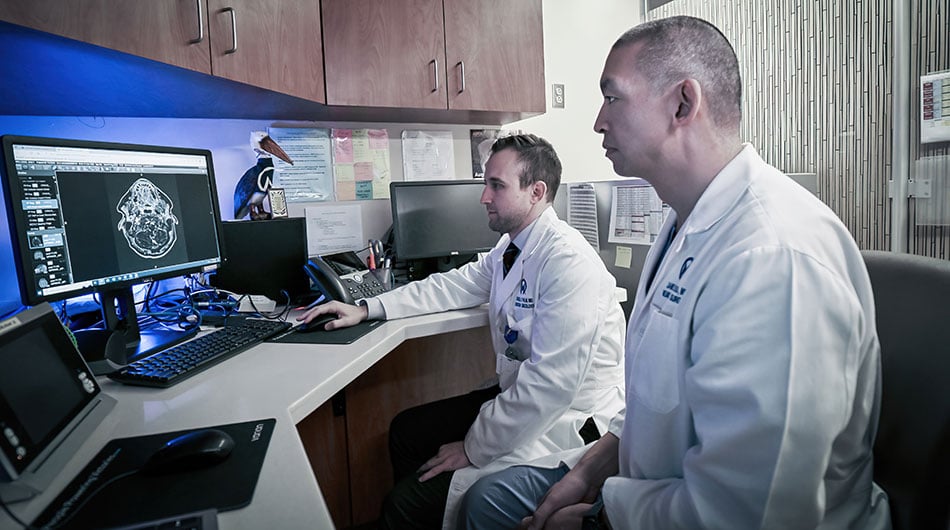Radiation Therapy for Glioblastoma
Glioblastoma is an aggressive brain cancer that originates in astrocytes, which are star-shaped glial cells that hold nerve cells in place and help them develop and function properly. The tumors tend to grow rapidly and invade surrounding brain tissues. Symptoms may include headaches, seizures, cognitive or personality changes and neurological deficits, which can vary based on the location of the tumor in the brain.
Known for its heterogeneous nature, glioblastoma can have various genetic mutations and a complex network of cells, which can complicate treatment. The most common approach is radiation therapy, which is often administered after surgery to destroy any remaining microscopic cancer cells and help prevent a recurrence. Radiation therapy can also be used as a standalone treatment for a tumor that is considered inoperable due to its size or critical location.

What does radiation therapy for glioblastoma involve?
Radiation therapy for glioblastoma involves the use of powerful X-rays, gamma rays or protons to destroy cancerous cells in the brain. In many cases, the treatment begins a few weeks after surgery was performed to remove as much of the tumor as possible. The high-energy beams are precisely directed at the tumor site to minimize exposure to the surrounding healthy brain tissues.
The latest radiation delivery techniques include:
Intensity-modulated radiation therapy (IMRT)
IMRT for glioblastoma is an advanced radiation treatment that involves the use of a computer-controlled external machine (linear accelerator), which generates and delivers highly precise radiation doses to a tumor. IMRT allows the physician to modulate the intensity and shape of the energy beams to conform with the three dimensions of the tumor. This heightened accuracy enables higher doses of radiation to be directed at a glioblastoma while minimizing exposure to the surrounding healthy brain tissues. To maximize tumor control and minimize side effects, IMRT is typically administered in daily sessions over several weeks.
Stereotactic radiosurgery (SRS)
SRS for glioblastoma is a noninvasive treatment that involves the use of focused beams of high-dose radiation to target and destroy tumor cells with a high level of precision. Unlike traditional surgery, SRS does not involve incisions; instead, it relies on advanced imaging and computer technology to deliver radiation precisely to the tumor site while sparing surrounding healthy brain tissues. This radiation delivery technique is typically used for small, well-defined tumors or for treating residual tumor cells following conventional surgery. SRS can be performed in a single session or over a few sessions, providing an effective option for managing glioblastoma with minimal impact on the patient’s overall health.

"Life hands you a challenge and you just have to know how to go with what is there."
Request an AppointmentWhat are the risks and possible complications of radiation therapy for glioblastoma?
Radiation therapy for glioblastoma can sometimes reach and damage healthy tissues near the tumor. This can cause side effects, such as:
- Fatigue
- Nausea and vomiting
- Red, irritated, dry, swollen or blistered skin (radiation dermatitis)
- Hair loss
- Low blood cell counts
- Headaches
- Seizures
- Hearing loss
- Cognitive changes, such as impaired concentration, memory or speech
Some side effects of radiation therapy for glioblastoma may develop during treatment while others may not appear for up to a year or two after treatment is completed. Although healthy cells cannot be completely shielded from radiation exposure, precise radiation delivery techniques can limit it, reducing the risk of side effects.
What to expect during recovery from radiation therapy for glioblastoma
As a patient recovers from radiation therapy for glioblastoma, they can generally expect to experience a gradual improvement in certain side effects, such as fatigue, nausea and skin irritation. However, the associated cognitive changes may persist and require ongoing management.
The patient will have regular follow-up appointments to allow their healthcare team to monitor for any late-onset side effects and assess the effectiveness of the treatment. Supportive care, such as physical therapy, occupational therapy or cognitive rehabilitation, may be considered to help the patient regain strength, function and quality of life. Emotional and psychological support through counseling or support groups can also be beneficial during recovery.
How effective is radiation therapy for glioblastoma?
Radiation therapy is often a critical component of glioblastoma treatment. While not a cure, it can effectively reduce the size of a tumor, slow its progression and alleviate its symptoms, thereby improving the patient’s quality of life. When combined with surgery and chemotherapy, particularly the drug temozolomide, radiation therapy has been shown to significantly increase median survival rates.
Due to the aggressive and infiltrative nature of glioblastoma, however, recurrence is common. Advances in radiation delivery techniques, such as IMRT and SRS, have improved outcomes, and scientists continue to explore ways to enhance the effectiveness of radiation therapy for glioblastoma.
Benefit from world-class care at Moffitt Cancer Center
The multispecialty team in Moffitt’s high-volume Neuro-Oncology Program includes experienced radiation oncologists, radiation therapists, dosimetrists and physicists. While our radiation delivery technologies—such as IMRT and SRS—set us apart, our skilled medical professionals truly make the difference. Through ongoing research and clinical trials, we are continually evaluating new ways to use radiation therapy for glioblastoma, helping each patient achieve the best possible outcome and quality of life.
If you would like to learn more about radiation therapy for glioblastoma, you can request an appointment with a specialist in our Neuro-Oncology Program by calling 1-888-663-3488 or submitting a new patient registration form online.
Treatment
